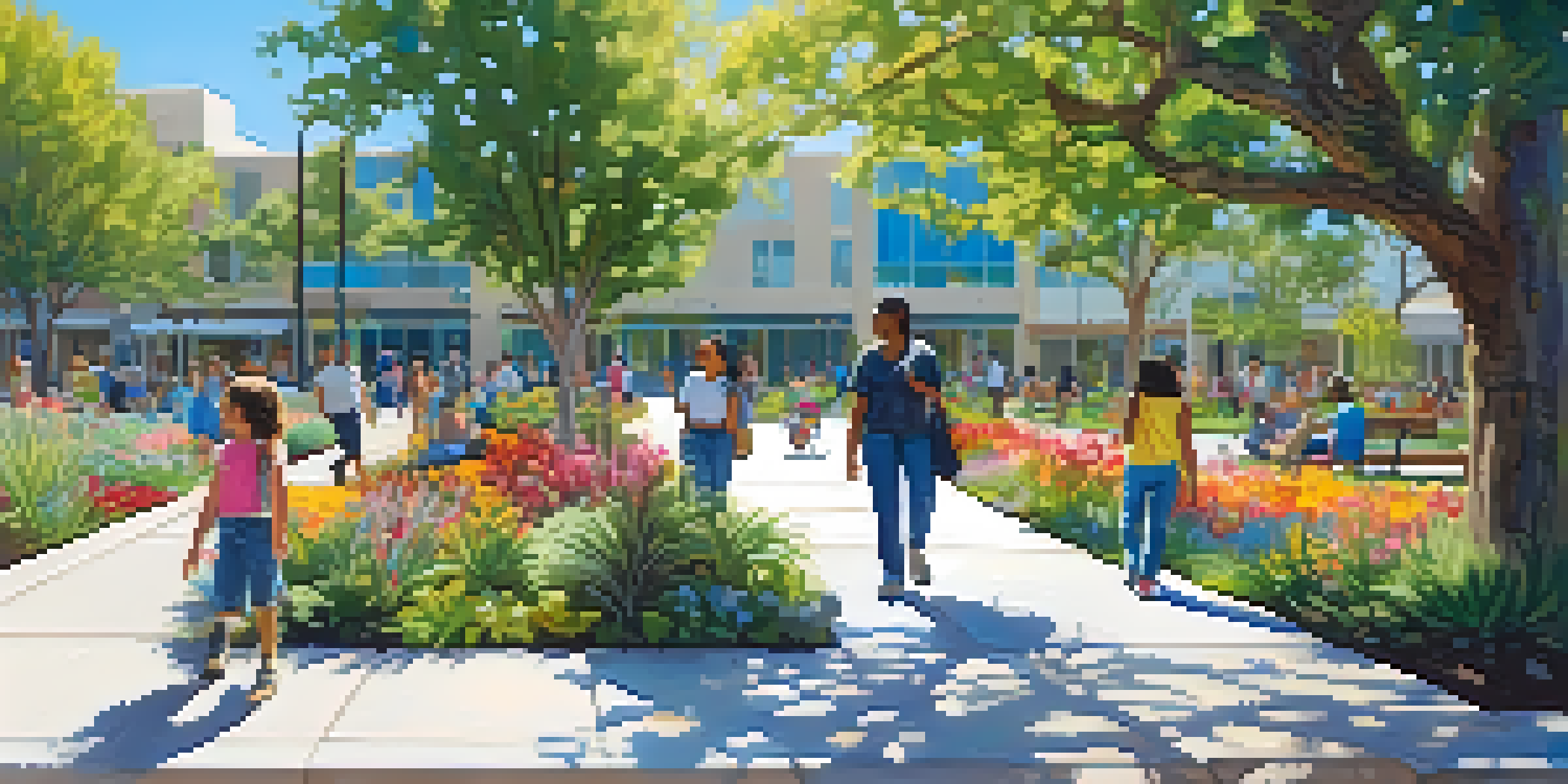Sustainable Urban Planning Practices in Major Californian Cities

Understanding Sustainable Urban Planning in California
Sustainable urban planning is a crucial approach that prioritizes eco-friendly practices in city development. In California, this concept has gained traction as cities face challenges like climate change and population growth. By integrating sustainability into urban design, cities aim to create environments that are livable, resilient, and resource-efficient.
Sustainable urban planning is not just a trend; it's a necessity for California's cities as they navigate complex challenges.
This practice involves considering factors such as transportation, energy use, and green spaces to enhance the quality of life for residents. With California being a trendsetter in environmental policies, many cities are leading the way in implementing innovative strategies. Sustainable urban planning is not just about building; it's about building wisely.
Incorporating sustainable practices helps cities reduce their carbon footprint while fostering community engagement. By focusing on long-term solutions, California's urban planners are effectively addressing the needs of both current and future generations. As we delve into specific cities, we'll uncover how diverse strategies are being employed to promote sustainability.
Los Angeles: Innovations in Public Transportation
Los Angeles has long been known for its car culture, but recent initiatives are transforming its public transportation system. The city's efforts to expand its metro lines and improve bus services are crucial elements of sustainable urban planning. By encouraging more residents to use public transport, LA aims to reduce traffic congestion and lower emissions.

Innovations like the Metro Bike Share program and electric buses showcase LA's commitment to eco-friendly transportation. These initiatives not only make commuting easier but also promote healthier lifestyles by encouraging cycling and walking. The shift towards improved public transportation reflects a broader understanding of sustainability in urban design.
California's Eco-Friendly Urban Planning
Sustainable urban planning in California focuses on integrating eco-friendly practices to address challenges like climate change and population growth.
With ongoing projects and community involvement, Los Angeles is gradually reshaping its identity from car-centric to transit-oriented. This transition not only enhances mobility but also fosters a sense of community. As LA continues to innovate, it sets a powerful example of how urban planning can support sustainability.
San Francisco: Embracing Green Architecture
San Francisco is at the forefront of sustainable architecture, with many buildings designed to minimize environmental impact. The city's commitment to green building practices is evident in its strict regulations and incentives for energy-efficient construction. By integrating renewable energy sources and sustainable materials, San Francisco aims to reduce its overall carbon footprint.
The future of urban planning in California is bright, with an emphasis on sustainability that will benefit generations to come.
One notable example is the San Francisco Public Utilities Commission building, which achieved LEED Platinum certification. This landmark structure exemplifies how innovative design can enhance energy efficiency while creating a functional workspace. The city encourages developers to prioritize sustainability, resulting in a skyline that reflects its eco-conscious values.
Additionally, San Francisco's focus on retrofitting existing buildings with green technologies contributes to its sustainable goals. By improving older structures, the city not only preserves its history but also reduces waste and energy consumption. This blend of old and new showcases how urban planning can harmonize with environmental stewardship.
San Diego: Prioritizing Green Spaces and Biodiversity
San Diego is renowned for its beautiful beaches and parks, but its commitment to green spaces goes beyond aesthetics. Urban planners are increasingly recognizing the importance of biodiversity and natural habitats in city design. By creating more parks, community gardens, and green corridors, San Diego is enhancing its residents' quality of life while promoting ecological health.
The city's 'Parks Master Plan' aims to ensure that every resident lives within a 10-minute walk of a park. This initiative not only encourages outdoor activity but also fosters community interaction. Green spaces play a vital role in urban ecosystems by supporting wildlife and improving air quality.
Innovative Transportation in LA
Los Angeles is transforming its public transportation system to reduce traffic congestion and emissions through initiatives such as expanded metro lines and electric buses.
Moreover, San Diego's efforts to preserve its coastal and marine environments reflect a comprehensive approach to sustainability. By integrating ecological considerations into urban planning, the city is setting a standard for how urban areas can coexist with nature. This emphasis on green spaces exemplifies the holistic vision of sustainable urban development.
Sacramento: Sustainable Water Management Practices
Sacramento faces unique challenges regarding water management, given its location in California's drought-prone region. Sustainable urban planning in the city incorporates innovative strategies to conserve water and promote efficient use. Technologies like rainwater harvesting and greywater recycling are becoming increasingly popular in new developments.
The city's commitment to sustainable water practices is evident in its 'Water Conservation Program,' which aims to reduce water use across various sectors. By educating residents and businesses on conservation techniques, Sacramento is fostering a culture of sustainability. This proactive approach not only addresses immediate concerns but also prepares the city for future challenges.
Additionally, Sacramento's emphasis on green infrastructure, such as permeable pavements and bioswales, enhances its ability to manage stormwater effectively. These features not only mitigate flooding but also recharge groundwater supplies. Through these sustainable water management practices, Sacramento is paving the way for a resilient urban future.
Fresno: Community Engagement in Urban Planning
Fresno's approach to sustainable urban planning emphasizes the importance of community engagement. By involving residents in decision-making processes, the city ensures that new developments align with local needs and values. This participatory approach not only fosters a sense of ownership but also enhances the effectiveness of sustainability initiatives.
Public forums and workshops allow community members to voice their opinions on urban projects, leading to more inclusive planning. This involvement is crucial in addressing issues such as housing affordability and access to green spaces. Fresno's commitment to transparency in urban planning strengthens community ties and promotes collective responsibility.
Community Engagement in Fresno
Fresno emphasizes community involvement in urban planning, ensuring developments reflect local needs and values while fostering a culture of sustainability.
Moreover, local partnerships with non-profit organizations and schools help educate residents on sustainability practices. By empowering communities, Fresno is not only building a greener city but also cultivating a culture of environmental stewardship. This grassroots approach demonstrates how urban planning can thrive through collaboration.
Long Beach: Integrating Technology for Sustainability
Long Beach is leveraging technology to enhance its sustainable urban planning efforts. Smart city initiatives are transforming the way the city manages resources and engages with residents. By utilizing data analytics and IoT (Internet of Things) devices, Long Beach aims to improve energy efficiency and reduce waste.
One notable example is the implementation of smart streetlights that adjust brightness based on foot traffic and vehicle presence. This innovation not only saves energy but also enhances public safety. Furthermore, Long Beach's use of technology in waste management, such as smart bins, facilitates more efficient recycling processes.

By integrating technology into urban planning, Long Beach is setting an example of how cities can use innovation to promote sustainability. These initiatives not only benefit the environment but also improve the overall quality of life for residents. As technology continues to evolve, Long Beach is poised to remain at the forefront of sustainable urban development.
Conclusion: The Future of Sustainable Urban Planning in California
Sustainable urban planning is not just a trend; it's a necessity for California's cities as they navigate complex challenges. From transportation and architecture to water management and community engagement, each city is crafting its unique approach to sustainability. The collective efforts of these diverse cities highlight the importance of adaptability and innovation in urban planning.
As California continues to lead the way in sustainability, other regions can look to these cities for inspiration. The integration of eco-friendly practices not only addresses environmental concerns but also enhances the resilience of urban areas. A collaborative effort among city planners, residents, and stakeholders is essential for creating sustainable communities.
The future of urban planning in California is bright, with an emphasis on sustainability that will benefit generations to come. By embracing innovative practices and fostering community involvement, these cities are not just planning for the present—they're building a sustainable future. Together, they exemplify the transformative power of urban planning in creating greener, more livable cities.